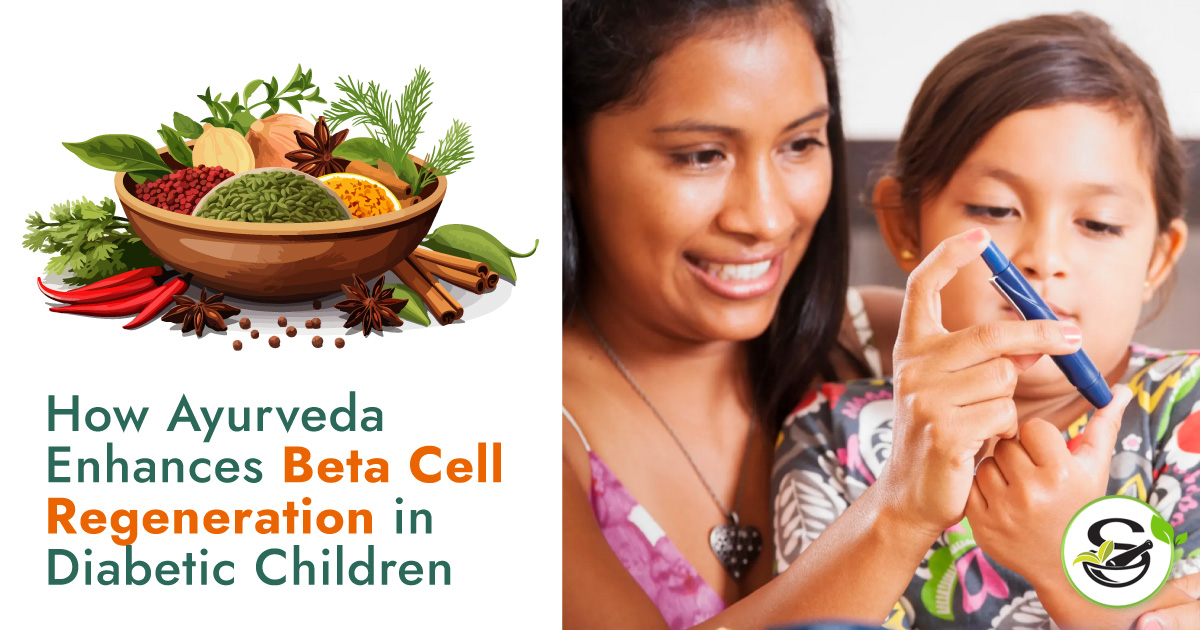
Introduction
Ayurveda, a centuries-old holistic healing system, continues to gain global attention for its potential in managing chronic diseases like diabetes, particularly in children with type 1 diabetes. While conventional medicine relies heavily on insulin therapy for children with diabetes, Ayurveda seeks to address the root cause—namely the destruction or dysfunction of beta cells in the pancreas that are responsible for insulin production.
Recent studies suggest that Ayurvedic herbs, dietary practices, and therapies can help stimulate beta cell regeneration, support insulin production, and improve overall metabolic health in diabetic children. In this comprehensive guide, we will explore the ways Ayurveda can enhance beta cell function, offering hope for more sustainable management of childhood diabetes.
Beta Cells and Their Role in Diabetes
Beta cells are specialized cells located in the islets of Langerhans in the pancreas, responsible for producing insulin, a hormone that regulates blood sugar levels. In type 1 diabetes, the body’s immune system mistakenly attacks and destroys these beta cells, leading to insufficient insulin production. Without insulin, the body cannot properly regulate glucose levels, leading to the dangerous highs and lows characteristic of diabetes.
Type 2 diabetes, is less common in children but still possible. Beta cells may still produce insulin, but the body resists its effects. Over time, the pancreas may fail to keep up with the body’s demands, leading to progressively worsening blood sugar control.
The loss or dysfunction of beta cells is central to both forms of diabetes, making beta cell regeneration a key target in improving outcomes for diabetic patients. This is where Ayurveda shines, offering potential tools to not only manage blood sugar but also support beta cell health and regeneration.
Ayurvedic Approach to Diabetes and Beta Cell Regeneration
Ayurveda takes a holistic view of diabetes, known as “Madhumeha” in classical Ayurvedic texts. According to Ayurvedic philosophy, diabetes is not just a metabolic disorder but also an imbalance in the body’s three doshas—Vata, Pitta, and Kapha—especially an aggravated Kapha. Ayurveda focuses on balancing these doshas, enhancing digestion, and detoxifying the body to restore the natural function of organs, including the pancreas.
Key Ayurvedic Principles for Beta Cell Regeneration:
- Detoxification (Shodhana): In Ayurveda, it is believed that accumulated toxins (ama) in the body can impair organ function, including the pancreas. Detoxification therapies such as Panchakarma are employed to cleanse the body, remove ama, and rejuvenate the beta cells.
- Herbal Remedies (Dravyaguna): Ayurveda employs specific herbs known for their anti-diabetic and beta-cell regenerative properties. These herbs not only lower blood sugar levels but also promote healing at the cellular level, including regeneration of the beta cells.
- Balancing Kapha and Pitta: Diabetes is considered a Kapha disorder with imbalances in Pitta, which influences digestion and metabolism. Ayurvedic treatments work to balance these doshas through diet, lifestyle changes, and targeted therapies, supporting overall metabolic health.
- Dietary Management (Pathya): The Ayurvedic diet emphasizes foods that regulate blood sugar and detoxify the system. Bitter foods and low glycemic index foods are particularly recommended to support beta cell health and improve insulin sensitivity.
Ayurvedic Herbs for Beta Cell Regeneration
Ayurveda leverages several potent herbs to stimulate beta cell regeneration, prevent further destruction, and support blood sugar management. Here’s a deeper look at how some of these herbs work:
Gymnema Sylvestre (Gurmar):
Known as the “sugar destroyer,” Gymnema Sylvestre is one of the most researched Ayurvedic herbs for diabetes. Clinical studies show that it can:
How to Use: Gymnema can be taken as a powder (churna) or in capsule form. For children, the dosage should be adjusted according to age and weight under the supervision of an Ayurvedic practitioner.
Tinospora Cordifolia (Guduchi):
Tinospora Cordifolia, also known as Amrita or Guduchi, is highly valued in Ayurveda for its rejuvenating and immune-modulating properties. In diabetes, Guduchi works by:
- Regenerating pancreatic cells: It is known to protect the pancreas from oxidative stress and promote the regeneration of beta cells.
- Immune modulation: Guduchi helps regulate the immune system, preventing it from attacking the beta cells in type 1 diabetes.
How to Use: Guduchi can be consumed as a decoction or in tablet form. It is often combined with other herbs like Turmeric and Neem to enhance its effects.
Bitter Melon (Karela):
Bitter melon has long been used in Ayurvedic medicine for its blood sugar-lowering properties. It contains polypeptide-p, an insulin-like compound that mimics the effect of insulin in the body. Additionally:
How to Use: Bitter melon juice can be consumed daily, or you can take it in powder or capsule form. However, it should be consumed in moderation to avoid hypoglycemia, particularly in children.
Curcumin (Turmeric):
Curcumin, the active compound in Turmeric, is widely studied for its anti-inflammatory and antioxidant properties. It can:
- Protect beta cells from inflammation: Chronic inflammation is a key factor in the destruction of beta cells. Curcumin helps reduce this inflammation, supporting beta cell survival.
- Promote regeneration: By reducing oxidative stress, curcumin creates a favorable environment for beta cell regeneration.
How to Use: Turmeric can be incorporated into the diet through food or taken as a supplement. Combining it with black pepper enhances curcumin absorption in the body.
Regenerate beta cells:
Gymnema is believed to increase the number of insulin-secreting beta cells, thereby improving insulin production.
Block sugar absorption:
It reduces sugar cravings by blocking the taste receptors on the tongue, making sweet foods less appealing.
Enhance insulin response:
Gymnema helps improve insulin sensitivity, which is beneficial in both type 1 and type 2 diabetes.
Promotes beta cell function:
Bitter melon is thought to stimulate the pancreas and may help in the regeneration of beta cells over time.
Regulates glucose metabolism:
It helps in reducing glucose production in the liver and improving glucose uptake by cells.
Ayurvedic Therapies for Beta Cell Health
Ayurveda goes beyond herbal remedies, offering a range of therapies that support pancreatic health and beta cell regeneration:
- Panchakarma Therapy:
Panchakarma is a detoxification procedure that helps remove accumulated toxins (ama) from the body, which can impair the function of vital organs like the pancreas. Panchakarma therapies such as Virechana (purgation) and Basti (enema) are specifically designed to detoxify the liver and pancreas, improving their ability to function optimally. These treatments are usually administered under the guidance of an Ayurvedic physician. - Abhyanga (Oil Massage):
Regular oil massages using medicated oils like Mahanarayan Oil help improve blood circulation, reduce stress, and stimulate the pancreas indirectly through improved metabolic function. - Shirodhara (Oil Dripping Therapy):
Shirodhara is a therapy in which a steady stream of warm oil is poured over the forehead, stimulating the pituitary gland. This therapy reduces stress hormones, which are known to affect insulin regulation and beta cell function.
The Role of Diet in Ayurvedic Diabetes Management
Ayurveda places great emphasis on diet as a means of managing diabetes and supporting beta cell health. A few key dietary recommendations include:
- Bitter Foods: Foods like bitter gourd, fenugreek, and neem are emphasized in Ayurveda for their ability to regulate blood sugar and support beta cell function.
- Low Glycemic Index Foods: Whole grains like millets, quinoa, and brown rice are recommended for their slow-release energy, helping to prevent sharp spikes in blood sugar.
- Avoid Processed Foods and Sugars: Ayurvedic guidelines strongly discourage the consumption of processed sugars, fried foods, and artificial sweeteners. Which aggravates the Kapha dosha and worsen insulin resistance.
Modern Research and Ayurveda: Bridging Ancient Wisdom with Science
Modern research into the regenerative properties of Ayurvedic herbs is beginning to validate the ancient wisdom. For example:
- Gymnema Sylvestre has been shown in clinical studies to promote beta cell regeneration in animal models and improve insulin levels.
- Curcumin has been demonstrated to protect beta cells from oxidative damage, one of the leading causes of beta cell dysfunction in diabetes.
These findings offer a scientific basis for incorporating Ayurveda into diabetes management. Especially for children with type 1 diabetes, where conventional treatments focus solely on managing symptoms rather than addressing the root cause.
Conclusion
Ayurveda offers a promising complementary approach to managing diabetes in children by enhancing beta cell function and promoting overall pancreatic health. Through the use of herbal remedies, dietary changes, and detoxifying therapies. Ayurveda helps address the underlying causes of diabetes, offering hope for better long-term outcomes.
While Ayurvedic practices show potential, it’s essential to consult both a qualified Ayurvedic practitioner and a healthcare provider to ensure that treatments are safe and appropriate for children. When integrated properly, Ayurveda could help manage diabetes in a natural, holistic manner, improving quality of life for diabetic children.
Read More: How to Manage Blood Sugar Spikes After Meals
